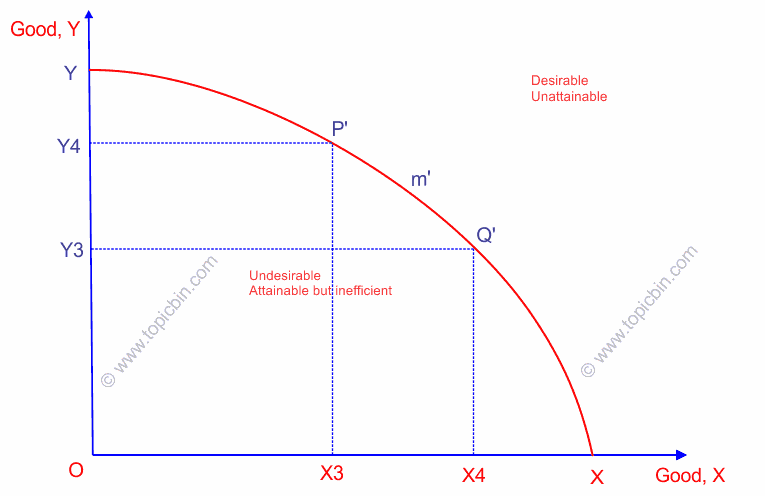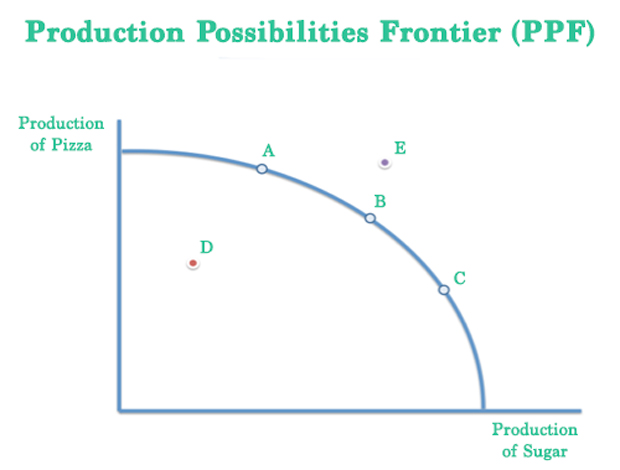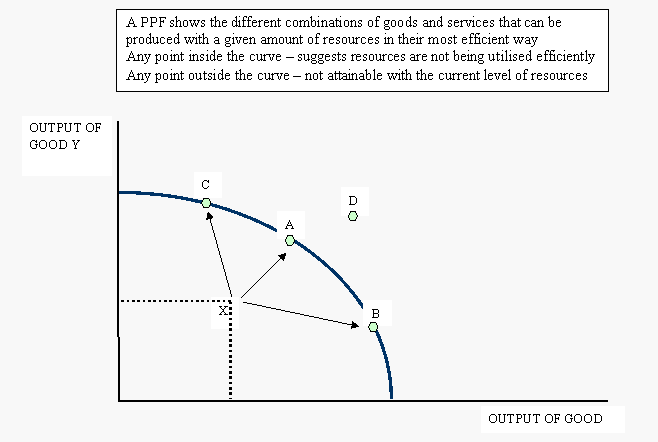
However, as more sheds are produced, the opportunity cost is higher and the curve is steeper.As such, very few puffs are given up to produce one shed. The production of the first shed, moving from point A to point B, uses resources best suited for shed production and least suited for crab puffs production. With relatively few sheds produced, the opportunity cost is low and the curve is flat.The law of increasing opportunity cost states that the opportunity cost of producing a good increases as more of the good is produced. The reason for this convex shape rests with the law of increasing opportunity cost, one of the more important principles studied in economics. This reflects an increasing opportunity cost of producing storage sheds, resulting in a convex shape for the production possibilities curve. Moving along the production possibilities curve, the slope becomes steeper (that is, the absolute value of the slope increases), reaching a value of -200 (an absolute value of 200) between points J and K. The opportunity cost of producing the first shed, and the slope of the curve moving from point A to point B is 5 dozen crab puffs (or -5). The opportunity cost values for segments between each pair of points is presented on this production possibilities curve. The slope of the production possibilities curve is the opportunity cost of the good measured on the horizontal axis, which in this example is storage sheds.

Increasing Opportunity Cost Increasing Opportunity Cost ( Hint: It is 8 dozen crab puffs, the difference between 445 dozen and 437 dozen.) These values are negative, which indicates the opportunity cost tradeoff between storage sheds and crab puffs. Using a similar process, the opportunity cost of producing the second shed can be easily determined.

The rise is a decrease of 70 and the run is an increase of 1.Ĭlick the button to illustrate. Here is a handy formula for calculating the slope of the production possibilities curve.įor example, the slope of the production possibilities curve between points I (8 sheds and 270 dozen crab puffs) and J (9 sheds and 200 dozen crab puffs).

Another way of saying this is to divide the rise by the run.įor a production possibilities curve that illustrates the production of crab puffs and storage sheds, this is the change in the quantity of crab puffs (rise) divided by the change in the quantity of storage sheds (run). Starting with SlopeThe slope of a line is measured by calculating the change in the value measured on the vertical axis divided by the change in the value measured on the horizontal axis. This tradeoff reflects the fundamental concept of opportunity cost. If all available resources are engaged production, then an increase in the production of one good requires a reduction in the production of the other good. This tradeoff occurs due to limited resources. The slope of a production possibilities curve illustrates the tradeoff between the production of two goods. SLOPE, PRODUCTION POSSIBILITIES CURVE: The numerical value of the slope of the production possibilities curve, which illustrates the alternative combinations of two goods that an economy can produce with given resources and technology, is the opportunity cost of producing the good measured on the horizontal axis. In particular, the appreciation of a nation's money is seen by an increase in the exchange rate caused by a growing, expanding, and healthy economy. While all sorts of stuff can appreciate in value, some of the more common ones are real estate, works of art, corporate stock, and money. Appreciation is only those price increases that reflect greater consumer satisfaction and thus value.

"More or less permanent" doesn't include temporary, short-term jumps in price that are common in many markets. AmosWEB means Economics with a Touch of Whimsy!ĪPPRECIATION: A more or less permanent increase in value or price.


 0 kommentar(er)
0 kommentar(er)
